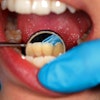“There’s something very magical about salivary diagnostics.”
– David Wong, DMD, DMSc,
director, Dental Research Institute, UCLA School of Dentistry
|
Salivary diagnostics goes commercial
Saliva's potential as a keeper of secrets has unfolded slowly. In the 1970s and 1980s, researchers identified levels of serum albumin in saliva and cortisol concentrations in oral fluids (Helvetica Odontologica Acta, April 1970, Vol. 14:1, pp. 10-17; Annals of Clinical Biochemistry, November 1983, Vol. 20:Pt 6, pp. 329-335). In the 1990s, researchers at the Naval Medical Center in Portsmouth, VA, and the University of Pennsylvania School of Dental Medicine described antibodies in saliva and an oral fluid test that can mark HIV with a specificity and sensitivity equal to that of blood serum (American Journal of Medicine, April 1, 1997, Vol. 102:4A, pp. 15-20; April 1997, Vol. 102:4A, pp. 9-14). Years later, the FDA-approved OraQuick Advance Rapid HIV-1/2 antibody test (OraSure Technologies) was introduced to the market. Additional chairside products have been introduced to detect hormones in saliva (ZRT Laboratory) and identify the type of oral human papillomavirus for evaluating head and neck cancer risk (OralDNA Labs). OralDNA also offers bacterial and genomic biomarker tests for periodontal disease, while OraSure markets saliva-based screening tests for alcohol and substance abuse. |
“Much will depend on the technology as it evolves and also the cost of that technology.”
– Daniel Meyer, DDS, ADA
senior vice president for scientific and professional affairs
“Once one is successful in getting a new benefit covered, getting the profession to use the new service requires significant education for acceptance.”
– Jed Jacobson, DDS,
chief science officer, Delta Dental of Michigan















